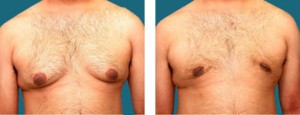Answering Some Common Questions about Male Breast Reduction & Gynecomastia
For many men, the idea of breast enlargement can seem pretty embarrassing. But the truth is that male breast enlargement, or gynecomastia, is far more common than you may know. In fact, the American Society for Aesthetic Plastic Surgery (ASAPS) estimates that gynecomastia affects roughly 40% of the male population in the US. Gynecomastia can be caused by many things including hormonal changes, hereditary factors, or certain health conditions. Regardless of the cause, gynecomastia can be a source of significant frustration and self-consciousness for men of all ages.
 For men who seek to rid themselves of their enlarged breasts, male breast reduction surgery may be the solution they desire. By removing excess breast tissue and fat (as well as excess skin in certain cases) male breast reduction is able to give the chest a more sculpted and masculine contour. I have witnessed firsthand the tremendous, long-lasting results this procedure is able to provide. For patients who are curious about gynecomastia and how male breast reduction can help, I have provided answers to the following commonly asked questions:
For men who seek to rid themselves of their enlarged breasts, male breast reduction surgery may be the solution they desire. By removing excess breast tissue and fat (as well as excess skin in certain cases) male breast reduction is able to give the chest a more sculpted and masculine contour. I have witnessed firsthand the tremendous, long-lasting results this procedure is able to provide. For patients who are curious about gynecomastia and how male breast reduction can help, I have provided answers to the following commonly asked questions:
What drugs or substances can increase my risk of gynecomastia?
In addition to the causes listed above, a number of medications and drugs can potentially increase a man’s risk of developing enlarged breasts. These can include steroids, certain antibiotics, medicines used to treat heart conditions, some chemotherapy drugs, and more. Consuming alcohol or certain recreational drugs like marijuana, methamphetamine, and heroin may also lead to gynecomastia.
What ages are men potentially vulnerable to gynecomastia?
The truth is, gynecomastia can affect men from birth all throughout adulthood. For newborns, breast enlargement is caused by estrogen from the mother, though this typically goes away after about six months. For teenagers and preteen boys, breast enlargement can occur as a result of hormonal fluctuation during puberty. This too will typically correct itself over time. For adult men who experience gynecomastia, surgical intervention is typically required to minimize the symptoms.
What can I do after my male breast reduction surgery to achieve the best results?
Like any other plastic surgery procedure, it’s vital that you closely follow your surgeon’s pre and post-op instructions. After the procedure, I instruct my patients to wear a compression garment to minimize swelling and support their new chest contour as it heals. Male breast reduction patients should wait about a week before returning to work (though this depends on their job) and at least two to three weeks before exercising following their procedure.
I hope you found these answers helpful. No matter the patient’s age or the cause of their condition, I believe male breast reduction can be a life-changing procedure for men trying to achieve a more desirable contour. To discuss whether you may be a candidate for male breast reduction surgery, please contact me, Dr. Franklyn Elliott, to schedule a consultation today. Or, for more of the latest plastic surgery news and helpful information, follow me on Facebook, Twitter, and Google+.

 The overdevelopment of male breast tissue is referred to medically as gynecomastia, which can occur in men of any age for a variety of reasons. Hormonal changes, genetics, and even the use of certain prescription medications can contribute to the growth of excess tissue. When working with a patient who is experiencing these issues, I use
The overdevelopment of male breast tissue is referred to medically as gynecomastia, which can occur in men of any age for a variety of reasons. Hormonal changes, genetics, and even the use of certain prescription medications can contribute to the growth of excess tissue. When working with a patient who is experiencing these issues, I use